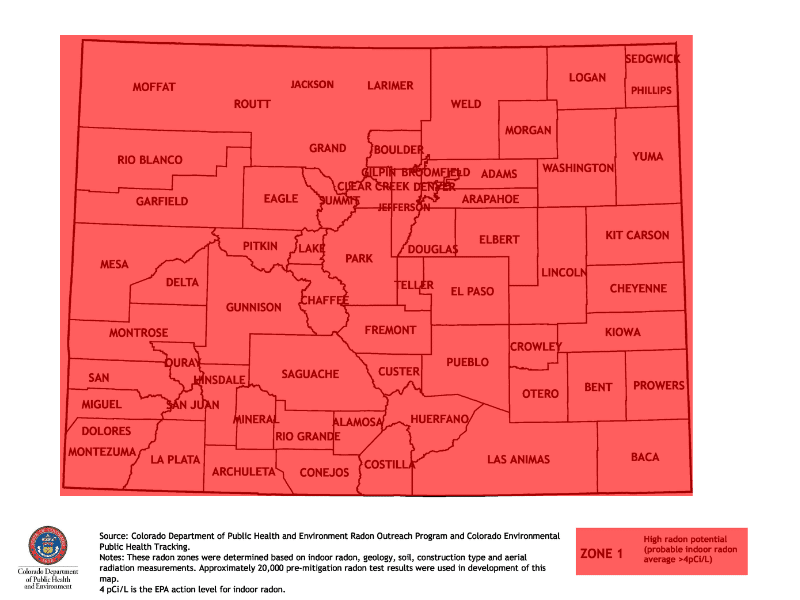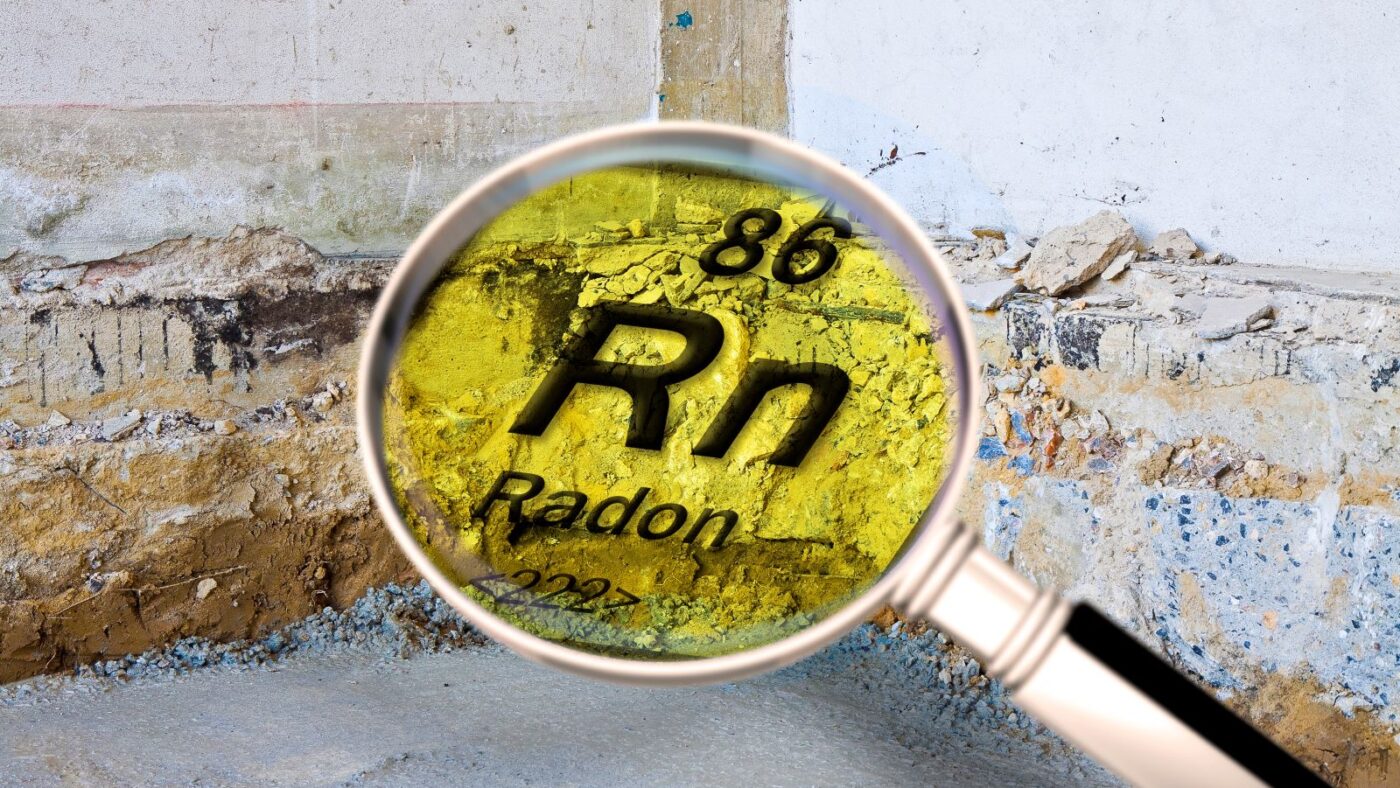Radon in Colorado: What’s New?
As the environmental industry evolves, newer concerns become relevant that may have not been considered such in years past. This is the result of updated research and development allowing for more concise regulations and standards that affect all facets of industry surrounding these environmental concerns. In this post, we will provide an update on radon standards and regulations and the recent legislation passed in the state of Colorado and how it may impact local businesses.
Based on recommendations from the Colorado Department of Public Health and Environment (CDPHE), Colorado is considered to be within Zone 1, predicting the average indoor screening level of radon to be greater than 4 picoCuries per liter (pCi/L), throughout the whole state. According to research conducted at Colorado State University (CSU), the average indoor radon level in Colorado is approximately 6.3 pCi/L (CSU, 2016) and according to the CDPHE, 48.3% of all single-family residential homes tested between 2005-2022 in Colorado exceeded the EPA recommended action level. Despite this, the state of Colorado does not require testing, and the only way to determine accurate radon levels in a home or building is by testing. The map below depicts the adopted CDPHE radon zone map (which is more conservative than the EPA radon map for the state).

CDPHE Radon Zone Map.
Recent Legislation
In June of 2021, Colorado lawmakers approved Colorado House Bill 1195 (HB21-1195), which created a regulatory framework for individuals practicing as radon measurement professionals or radon mitigation professionals. This effectively made Colorado one of the few states requiring radon professionals to be licensed, which is regulated by the Department of Regulatory Agencies (DORA) of Colorado. HB21-1195 requires contractors to:
- Take and pass a National Radon Proficiency Program (NRPP) of National Radon Safety Board (NRSB) accredited course;
- Take and pass an approved examination;
- Register with DORA; and
- Follow American National Standards Institute American Association of Radon Scientists and Technologists (ANSI AARST) protocols when in the field.
AARST is the organization that oversees the administration of licensing and testing. They also work to develop industry standards and provide insight to the public regarding health risks. AARST has established the measurement, mitigation and quality control/quality assurance protocols in coordination with ANSI.
Additionally, Colorado lawmakers approved Senate Bill 23-206 (SB23-206) in June of 2023, requiring landlords and home sellers to give written disclosures on the risks of radon to future occupants. SB23-206 does not require radon testing, but if the seller has knowledge of prior testing and/or mitigation being done at the property, they are required to release this information to the prospective buyer or tenant. The bill requires the following disclosures be provided for residential property sale contracts:
- A bold-typed advisory statement on residential real estate contracts for sale;
- The most recent records and reports on radon levels detected at the property;
- A description of radon levels detected;
- A description of treatment, mitigation, or remediation performed at the property; and
- An electronic or paper copy of the most recent information from the CDPHE to advise about radon in real estate transactions.
If these notices are not provided to the prospective buyer or tenant, the seller can be held liable and forced to pay for court costs, radon testing, and mitigation.
HB21-1195 and SB23-206 allows both private contractors and their clients to approach radon with more transparency and peace of mind prior to the enactment. Acknowledging that the testing for radon, installation of radon mitigation systems, and future real estate transactions are putting health and transparency at the forefront, enables consumers to be more aware of issues with radon.
With the issuance of HB21-1195, all radon measurement, mitigation, and quality control professionals need to be in compliance with ANSI AARST protocols which were updated in 2023.
Impacts of the Recent Legislation and Adoption of AARST Standards
Although Colorado does not require testing, certain lending institutions may require radon testing prior to a real estate transaction. Radon testing completed in Colorado must be done by a radon professional, and the standards have to be adhered to.
Radon measurement standards require 100% of ground floor or ground contact floor (i.e., have floors or walls in contact with the ground or are the closest level over untested ground-contact locations (i.e., crawl space) that are occupied and any room with the intent to be occupied. Additionally, 10% of occupied or rooms with the intent to be occupied on each upper floor have to be tested.
If a home, school, and/or workplace records elevated radon levels following testing, above 4 pCi/L, then a radon mitigation system is recommended.
Typically, radon issues are resolved using an underground ventilation system or by increasing the rate of air exchanges in the building. Radon mitigation systems can include sub-slab depressurization (the most common), drain tile suction, sump pit suction, and block wall suction (CSU, 2016). Other actions that can help reduce radon infiltrating a building is by sealing cracks and other openings in the foundation and covering sump pump holes. Additionally, radon resistant building materials can be used during new construction, which can lower installation costs and allow for more flexibility when designing a mitigation system.
AARST Standards
VERTEX has provided a summary of the AARST standards as they a relate to the commercial real estate industry below:
Measurement Protocols
- ANSI/AARST MA-MFLB-2023 Protocol for Conducting Measurements of Radon and Radon Decay Products in Multifamily, School, Commercial and Mixed-Use Buildings
Mitigation Protocols
Existing buildings:
- ANSI/AARST SGM-MFLB-2023 Soil Gas Mitigation Standards for Existing Multifamily, School, Commercial and Mixed-Use Buildings
New construction:
- ANSI/AARST CCAH-2020-0523 Reducing Radon in New Construction of 1 & 2 Family Dwellings and Townhouses – Rev. 5/23
- ANSI/AARST CC-1000-2018-0523 Soil Gas Control Systems in New Construction of Multifamily, School, Commercial and Mixed-Use Buildings – Rev. 5/23
- ANSI/AARST RRNC-2020-1022 Rough-in of Radon Control Components in New Construction of 1 & 2 family dwellings and townhouses – Rev. 10/22
Quality Control Protocols
- ANSI/AARST MS-QA-2023 Radon Measurements Systems Quality Assurance
- ANSI/AARST MS-PC-2022 Performance Specifications for Instrumentation Systems Designed to Measure Radon Gas in Air
In addition to the above commercial real estate/institutional facility radon protocols, ANSI AARST also provides specific measurement and mitigation protocols for single-family residential dwellings as well which can be found at standards.aarst.org.
It should be noted that unlicensed radon measurement and/ or mitigation professionals may be subject to fines or criminal liability under Colorado’s radon laws and regulations, and unlicensed or unsatisfactory work may be reported at any time.
VERTEX will continue to monitor the scientific and regulatory developments surrounding radon both nationally and locally. VERTEX’s urgent and flexible approach assists clients who will inevitably be called upon to respond to insurance claims and remediation projects associated with radon in the coming years.
For more information on research and regulatory development into radon and environmental issues in Colorado, please contact Sarah Chase (schase@vertexeng.com) or Jesse Freeman (jfreeman@vertexeng.com).
References
Colorado Department of Public Health and Environment. “Understanding Radon.” CDPHE. Accessed January 5, 2024. https://cdphe.colorado.gov/hm/understanding-radon. Colorado State University. “Preventing Radon problems in the Home.” CSU. Last Modified December 2016..
General Assembly of the State of Colorado. House Bill 21-1195. Accessed November 29, 2023. https://leg.colorado.gov/sites/default/files/documents/2021A/bills/2021a_1195_01.pdf. .
General Assembly of the State of Colorado. Senate Bill 23-206. Accessed November 29, 2023. https://leg.colorado.gov/sites/default/files/2023a_206_signed.pdf.
National Research Council (US) Committee on Risk Assessment of Exposure to Radon in Drinking Water. “Risk Assessment of Radon in Drinking Water.” Washington (DC): National Academies Press (US). 1999. https://www.ncbi.nlm.nih.gov/books/NBK230511/#:~:text=The%20committee%20determined%20that%20the,that%20arises%20from%20other%20causes.
North Carolina Department of Health and Human Services. “Health Impacts from Radon.” NCDHHS. N.d. https://www.ncdhhs.gov/divisions/health-service-regulation/north-carolina-radon-program/health-impacts-radon#Tab-RadonRisksforNeverSmokers-3301.
U.S. Environmental Protection Agency. “What is Radon? Is it Dangerous?” USEPA. Last modified October 11, 2023. https://www.epa.gov/radiation/what-radon-gas-it-dangerous.




